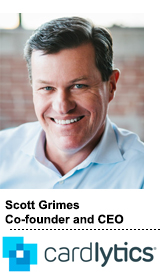 The payments data company Cardlytics, which went public in February, said in its first-ever earnings call Wednesday that it hopes to expand its advertising program and the marketing applications of its consumer spending data.
The payments data company Cardlytics, which went public in February, said in its first-ever earnings call Wednesday that it hopes to expand its advertising program and the marketing applications of its consumer spending data.
Cardlytics had $35.6 million in revenue during the second quarter, up from $32.8 million during the same period last year. The company was less profitable this past quarter, with an operating loss of $11.6 million compared to $5.3 million in Q2 2017, but the decline was due to the addition of 100 employees and more than $9 million in expenses in the past year.
Cardlytics works with banks to offer sponsored reward programs for their online and mobile banking customers. A bank might, for instance, offer a discount for a certain store. If users click, the bank provides cash back if it identifies the purchase in its monthly credit processing.
So Cardlytics’ inventory is tied to its banking partners’ messages. Those partners include Bank of America, JP Morgan and Wells Fargo.
But the company is looking for ways to apply its data to the broader media ecosystem.
“More and more we’re thinking about how we can connect to DSPs and automated buying processes,” said co-founder and CEO Scott Grimes.
Cardlytics’ recent IPO could help on that front. The company’s shares are up more than 50% since it joined the market, and its cash on hand has grown from $21.3 million at the beginning of the year to $50.5 million now, according to its earnings report this week.
“We very open and interested in doing acquisitions,” Grimes said, and the company is evaluating ways to buy or build its way into programmatic media.
Extending discount offers beyond bank-owned media could be a major growth opportunity for Cardlytics, Grimes said.
Huge programmatic gains have been made by companies like IRI and Nielsen Catalina Solutions that connect purchase data to media impressions, not to mention Amazon’s immense ad budgets tied to ecommerce attribution.
“Closing the loop is critical for a lot of media solutions today,” Grimes said. But that data mostly comes from store loyalty programs or very narrow data-sharing deals with credit card merchants or retailers, which limits the scale and introduces audience biases, he said.
The purchase data ecosystem can measure broad market lift or go through data-matching vendors that connect loyalty shoppers with online browsing, but it isn’t adequate for granular measurement, Grimes said.
One retail client, for instance, recently used Cardlytics to target a rival chain’s customers and attribute that activity to market share gains.
Grimes said that kind of granular conquesting doesn’t work with the current purchase data ecosystem, which only has extrapolated data, not individual consumer purchases at scale.
“One thing we know how to do but don’t do today is use our analytics and data not to measure our data but any kind of media, and at some point we’ll focus on that more,” Grimes said.
There are hurdles to joining the real-time bidding ecosystem.
For one thing, Cardlytics doesn’t deal much with agencies, a category it may have to build out to earn programmatic budgets.
More importantly, Cardlytics must also toe a line applying its purchase data to any non-bank media channel, and it must prevent other vendors from applying that data elsewhere.
Cardlytics, for instance, doesn’t allow advertisers to target bank customers and then find them elsewhere online by matching through a service like LiveRamp or Experian, Grimes said.
“We know the players like The Trade Desk, Oracle and DBM [the Google DSP recently rebranded to Display & Video 360] well and have had discussions about being in those marketplaces,” he said. “We’re thinking a lot about how to make those kinds of integrations work.”
This post was syndicated from Ad Exchanger.


More Stories
Daily Wire Welcomes Perplexity to Advertise on The Ben Shapiro Show
Here’s the Roundup for the Week Ending March 7
Aflac’s Dan Amos Reveals How He’s Successfully Held Onto the CEO’s Job for 35 Years